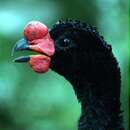Biology
provided by Arkive
Like most birds, these curassows roost in trees (5). However, they spend most of the day foraging on the ground, usually in pairs or small family groups of three or four birds (5), which may or may not include more than one adult female (6). This bird feeds on small fish, insects, aquatic crustaceans and other small animals, which are sought in flooded forest and along overgrown river-shores (2) (7). Fruit and seeds are also eaten, although the proportion of these in the diet appears to depend on seasonal abundance (2).
June is the peak month for male courtship displays and nesting (2) (6), with males displaying by laying their head back, raising their tail to show the white of the under-tail coverts, and trotting in circles around the female. A mated pair will usually build the nest together, but males may sometimes build a nest on their own and then go searching for a female with which to breed (5). Females are thought to incubate the two to six eggs alone, while the male guards the nest and territory, although conflicting reports exist (5) (6). Chicks have been observed in July (2), and they usually remain with their parents until they are fully grown (5).
Conservation
provided by Arkive
The wattled curassow is afforded some degree of protection in the Mamirauá Sustainable Development Reserve in Brazil, although it nevertheless continues to be hunted there, and Pacaya-Samiria National Reserve in Peru. A temporary hunting ban has been implemented in Bolivia in order to secure the future of local hunting stocks by allowing the population to recover, and this has reportedly had some success (2). It has been proposed that governments and nature reserves develop and help encourage ecotourism as an alternative means of income and subsistence for local people, and as a source of sustainable development for the country (2) (6). To this end, Asociación Armonía, the BirdLife International partner in Bolivia, is channelling funds into the development of a small scale ecotourism project in San Marcos in Bolivia, where the only remaining population of wattled curassows in the country is found (8) (9). Asociación Armonía has worked closely in conjunction with the local community of San Marcos to ensure that vital Bolivian populations are preserved (8). The area around this species has been petitioned as an 'indigenous territory', and there is now a boat to the area for tourism, with plans for a lodge, and trained guides, cooks etc. by 2007 (9). Similar initiatives in other range nations could significantly help the recovery of this species.
A reasonable-sized population is held in captivity but individuals are becoming increasingly scarce. Thus, the captive population in the US is managed by an AZA studbook held by Houston Zoo to minimise inbreeding (5). Captive populations provide potential for future reintroductions into the wild, but this is unlikely until a safer environment exists, in which reintroduced individuals would have a fair chance of survival.
Description
provided by Arkive
This charismatic forest bird derives its curious common name from the two well developed dangling wattles below the male's bill, which are coupled with a distinctive bulbous knob above, all being a conspicuous scarlet-red in breeding males and positioned around a similarly coloured cere (2) (4). Their vivid colour contrasts starkly with the primarily black plumage of the body, and similarly dark bill and legs (2). While the rest of the plumage is black, the lower abdomen and under-tail coverts are snow white in males, and dark reddish-cinnamon in females (2) (4). Males are also adorned with tightly curled black crest feathers, while the female's crest is narrowly barred with white (2) (5). However, the female can most readily be distinguished from the male by her conspicuous lack of the unusual wattles and knob around the bill, instead having only the simple orange-red cere (5).
Habitat
provided by Arkive
Found in lowland, riverine, humid forest (2).
Range
provided by Arkive
The wattled curassow is widespread in the Andean lowlands and Amazon basin, but its range and abundance have dramatically declined in recent years, with small, scattered, fragmented populations now remaining only in west Brazil, south Colombia, east Ecuador, east Peru and north Bolivia, (2) (5). It has been speculated that the Ecuador population is probably now extinct, while fewer than 300 individuals are thought to persist in Bolivia, fewer than 300 in Peru, and possible fewer than 100 in Colombia. The most important site for the species is Mamirauá in Brazil, which was estimated in 2005 to hold a population of well over 250 individuals (2).
Status
provided by Arkive
Classified as Vulnerable on the IUCN Red List 2006 (1), and listed on Appendix III of CITES in Columbia (3).
Threats
provided by Arkive
Sadly, the areas surrounding the Amazonian rivers to which this species is restricted are precisely those most useful and accessible to humans, with the rivers providing good transport links (2) (6). Thus, these areas have undergone considerable human colonisation, development and exploitation, with local settlements fragmenting critical curassow habitat (7). Additionally, commercial and subsistence hunting is higher in these areas because of the easy access via the rivers, and hunting is the primary cause of decline for this species (2) (7). In particular, the replacement of traditional hunting practices with shotguns had a dramatic impact, and the wattled curassow population plummeted (6). During the 1960s, this unusual and distinctive looking bird was heavily hunted for subsistence by fur traders on the río Beni in Bolivia, but the prohibition of fur-hunting by CITES in 1971 thankfully reduced this threat (2).

